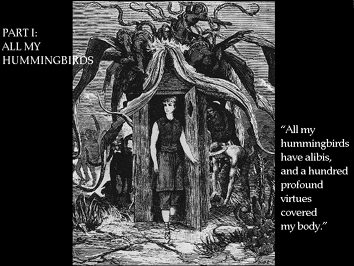 MIDI CHAMBER MUSIC
MIDI CHAMBER MUSIC
 MIDI CHAMBER MUSIC
MIDI CHAMBER MUSIC

|
The enigmatic title evokes the beautiful and the sinister--tiny, brightly colored birds with extensile tongues/an excuse to avert blame and punishment; it perfectly captures the haunting beauty of the compositions featured on this CD-ROM. Created by composer Morton Subotnick, this multimedia production offers two pieces for MIDI (Musical Instrument Digital Interface) keyboards, MIDI mallets, flutes, cello and computer. "All My Hummingbirds Have Alibis" and "5 Scenes from an Imaginary Ballet" are both based on Max Ernst's collage novel A little girl dreams of taking the veil . Images and text from Max Ernst's novel and Subotnick's music are combined into an amalgam of visual and musical beauty. Subotnick didn't use the full text of Max Ernst's collage novel; without altering the words, he excerpted selections of text from the pages that contain the images he used. The lyrical score describes relations between men and women, and we gradually learn that we're not dealing with hummingbirds having alibis, but with a little girl who has alibis for her joys.   The CD-ROM also provides background information on the composition and the technology used to create the music and to record it. MIDI was developed in the mid '80s and allows machines--computers and synthesizers--to communicate with each other. What is played back is not a sound, but the onset of a key press; the synthesizer simply duplicates the performance. Subotnick used a software program called Interactor (developed by himself and Mark Coniglio), which allows the composer to set up situations where a MIDI event can arrive and the program can intelligently respond to it. Interactor allows the computer to follow up to eight different tempi simultaneously. In his notes, Subotnick emphasizes the importance of real-time interaction between the computer and the performer: the choice of the right musical 'moment' ("when does it feel right for something to happen and how should it be played") is still essential to communicate the meaningfulness of a musical idea. What makes "Hummingbirds" a true multimedia experience is the way it fluently interweaves music, text and images to create a piece of art with a distinctly educational value. |